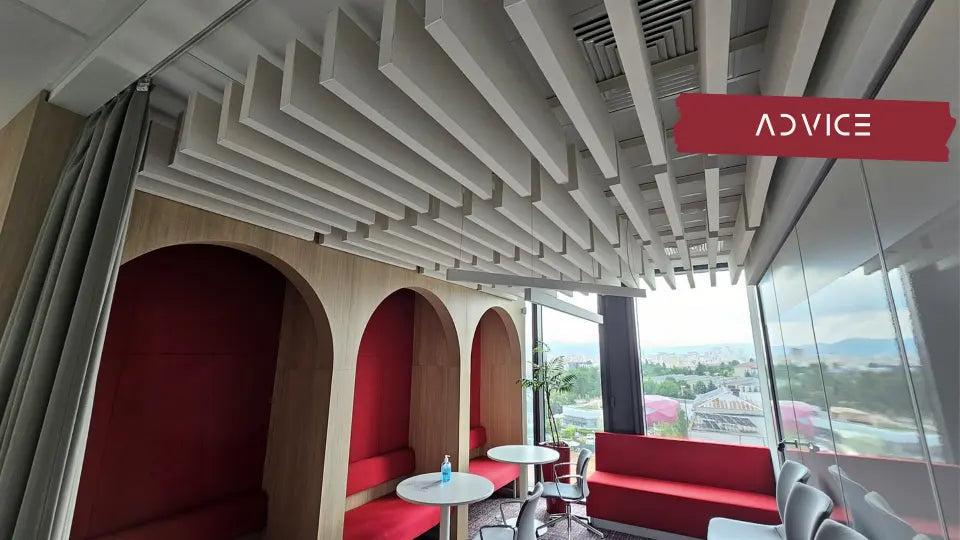
Kuinka akustinen hoito täydentää äänieristystoimia
Tanya IlievaJakaa
📖 Lukuaika: 3 min ja 32 sek
Mitä tulee melunhallintaan, molemmat äänieristys ja akustinen käsittely ovat tärkeitä tehtäviä, mutta niillä on eri tarkoitus. Äänieristys estää tai vähentää äänen siirtymistä tilojen välillä, kun taas akustinen käsittely keskittyy äänenlaadun parantamiseen huoneessa säätelemällä äänen heijastuksia ja jälkikaikuja.
Näiden kahden strategian yhdistäminen johtaa parhaaseen mahdolliseen akustiseen ympäristöön erityisesti asunnoissa, kotitoimistoissa ja työtiloissa, joissa tuottavuus ja mukavuus ovat etusijalla. Tässä artikkelissa tutkimme, kuinka akustinen käsittely täydentää äänieristystä, vastaa käyttäjien keskeisiin kysymyksiin ja paljastaa äänenhallinnan taustalla olevan tieteen.
Ero äänieristyksen ja akustisen käsittelyn välillä
Äänieristyksen ja akustisen käsittelyn välisen eron ymmärtäminen on ensimmäinen askel kohti tehokasta melunhallintaa. Äänieristyksen tarkoituksena on estää äänen pääsy tilaan tai sieltä poistuminen. Se vaatii materiaaleja ja rakennustekniikoita, jotka on suunniteltu estämään tai absorboimaan ääniaaltoja.
Tämä voi sisältää massan lisäämistä, ilmatiiviiden tiivisteiden luomista ja rakenteiden irrottamista äänen siirtymisen minimoimiseksi. Toisaalta akustinen käsittely keskittyy äänen käyttäytymiseen huoneessa. Se ei estä ääntä kulkemasta seinien läpi, mutta hallitsee tapaa, jolla ääniaallot heijastuvat pinnoilta, vähentäen kaikua ja parantaen selkeyttä.
Yksinkertaisesti sanottuna äänieristys käsittelee ulkoista melua, kun taas akustinen käsittely käsittelee sisäistä ääntä. Esimerkiksi meluisassa asunnossa äänieristysratkaisuina voidaan asentaa eristys tai tiivistää rakoja, jotka estävät ääntä pääsemästä sisään tai ulos. Samaan aikaan akustiset paneelit tai absorboivat materiaalit voivat auttaa vähentämään kaikua huoneen sisällä tehden tilasta hiljaisemman ja paremmin keskittyvän.

Auttaako akustinen käsittely äänieristykseen?
Vaikka akustinen käsittely ja äänieristys palvelevat eri tarkoituksia, ne toimivat parhaiten, kun niitä käytetään yhdessä. Akustinen käsittely ei sinänsä estä melua pääsemästä huoneeseen tai poistumasta siitä, mutta se tekee sisäisestä ympäristöstä hiljaisemman ja miellyttävämmän vaimentamalla liiallisia ääniheijastuksia. Kotitoimistossa tai studiossa akustiset paneelit vähentävät kaikuja ja lisäävät selkeyttä kokousten tai äänitysten aikana. Tämä jälkikaiunta saa tilan tuntumaan hiljaisemmalta, vaikka se ei estä ulkoista melua tunkeutumasta sisään.
Kun akustinen käsittely yhdistetään äänieristykseen, yleinen akustinen ympäristö paranee merkittävästi. Esimerkiksi, jos olet äänieristetty seinät, kattoon tai kerros melun vähentämiseksi akustiset paneelit voivat sitten optimoida äänen käyttäytymisen tilassa luoden tasapainoisen ja vähemmän häiritsevän ilmapiirin. Lisäksi akustinen käsittely voi minimoida melun havaitsemisen vähentämällä sisäisiä äänitasoja, mikä auttaa vaimentamaan ulkoista melua tehokkaammin.

Akustisten paneelien rooli asunnoissa ja yhteistiloissa
Asunnoissa tai yhteisissä tiloissa asuville naapureiden melu on yleinen huolenaihe. Vaikka akustiset paneelit eivät täysin estä kovia ulkoisia ääniä, ne voivat absorboida ääniaaltoja ja vähentää yleistä melutasoa omassa tilassasi. Tämä voi saada ulkoiset äänet näyttämään vähemmän häiritseviltä. Absorboimalla keski- ja korkeita taajuuksia akustiset paneelit auttavat estämään ääntä pomppimasta kovilta pinnoilta, kuten seiniltä ja katoilta, mikä luo miellyttävämmän kuuloympäristön.
Jos olet tekemisissä meluisten naapureiden kanssa, akustisten paneelien sijoittaminen jaetuille seinille voi auttaa vähentämään sisäistä melua absorboimalla huoneessasi syntyviä ääniä, kuten ääniä, musiikkia tai television melua.Tämä ei vain lisää mukavuuttasi, vaan myös rajoittaa ääntä, joka saattaa häiritä naapureitasi. Vaikka akustinen käsittely ei korvaa äänieristystä, se voi parantaa merkittävästi akustista laatua, varsinkin kun sitä käytetään yhdessä äänieristysmateriaalien, kuten eristeiden, paksumpien seinien tai äänieristysverhojen kanssa.
Kuinka akustinen käsittely ja äänieristys parantavat tuottavuutta
Melu voi olla merkittävä este tuottavuudelle, etenkin kotitoimistoissa, joissa keskittyminen on välttämätöntä. Tutkimukset osoittavat, että työpaikan melu voi johtaa tuottavuuden laskuun jopa 66%, jossa taustapuhinaa, elektronista kohinaa ja ulkoisia häiriöitä, jotka edistävät henkistä väsymystä. Akustinen käsittely voi auttaa parantamaan sisäistä ääniympäristöä, vähentämään kaikuja ja eliminoimaan keskittymiseen vaikuttavia häiritseviä jälkikaikuja.
Yhdistettynä äänieristykseen akustinen käsittely lisää tuottavuutta entisestään. Esimerkiksi äänieristetyssä toimistossa akustinen käsittely auttaa hallitsemaan äänen heijastuksia ja luo hiljaisemman ja keskittyneemmän ympäristön. Hallitsemalla äänen etenemistä huoneessa vähennät häiriötekijöiden todennäköisyyttä, mikä helpottaa keskittymistä tehtäviin. Tämä äänieristyksen ja akustisen käsittelyn välinen synergia on hyödyllinen myös luovissa tiloissa, kuten studioissa tai editointihuoneissa, joissa selkeys ja äänenhallinta ovat ensiarvoisen tärkeitä.

Äänen absorption ja diffuusion tiede
Akustisessa hoidossa käytetään pääasiassa kahta tekniikkaa: absorptio ja diffuusio. Absorptiossa käytetään materiaaleja, kuten akustista vaahtoa tai kangaspaneeleja, jotka imevät ääniaaltoja, estävät niitä heijastamasta seiniltä ja luomasta kaikuja. Nämä materiaalit vähentävät erityisen tehokkaasti korkeampia taajuuksia, jotka ovat ei-toivotun jälkikaiuntapääsyyllisiä. Tämä parantaa äänen selkeyttä ja vähentää kuulon väsymystä, jolloin tila tuntuu mukavammalta pidempiä työ- tai vapaa-aikoja varten.
Diffuusio puolestaan hajottaa ääniaallot tasaisesti koko tilaan. Sen sijaan, että ääniaaltojen heijastuisi suoraan takaisin huoneeseen aiheuttaen kaikuja tai "kuumia kohtia", joissa ääni on kovempaa tietyillä alueilla, diffuusorit levittävät ääntä tasaisemmin. Tämä luo tasapainoisen kuuloympäristön, jossa ääni jakautuu tasaisesti, mikä on erityisen hyödyllistä suuremmissa tiloissa, kuten kokoushuoneissa, teattereissa tai suurissa kotitoimistoissa.
Absorption ja diffuusion yhdistäminen varmistaa, että huoneessa on tasapainoinen akustiikka, vähennetty kaiku ja luonnollinen, tasainen ääni. Yhdessä äänieristystoimenpiteiden kanssa, jotka estävät melua, tämä luo ihanteellisen akustisen ympäristön sekä työhön että rentoutumiseen.

Käytännön vinkkejä äänieristyksen ja akustisen hoidon yhdistämiseen
Maksimaalisen äänenhallinnan saavuttamiseksi yhdistä äänieristys ja akustinen käsittely seuraavasti:
Vaihe 1: Äänieristä huoneen rakenne
Aloita huoneen tärkeimpien rakenneosien äänieristyksestä. Tiivistä ovien ja ikkunoiden ympärillä olevat raot ja käytä raskaita verhoja tai kaihtimia estääksesi ulkoisen melun. Eristä seinät, lattia ja katto todistetuilla äänieristystuotteilla, kuten MYKISTYSJÄRJESTELMÄ tai
Vaihe 2: Lisää akustinen hoito sisäiseen äänenhallintaan
Kun huoneesi on äänieristetty, ota käyttöön akustinen käsittely. Asenna seinään asennettavat akustiset paneelit, jotka on valmistettu materiaaleista, kuten esim puu, akustinen kangas,

Vaihe 3: Valitse kaksitoimiset materiaalit
Jotkut materiaalit voivat palvella sekä äänieristys- että akustisia käsittelytarkoituksia. Esimerkiksi tiheät matot voivat auttaa vähentämään melun siirtymistä lattioiden läpi ja samalla hallita äänen heijastuksia huoneessa. Lisäksi akustinen vaahto paneelit korkea NRC (Noise Reduction Coefficient) voi toimia sekä esteenä että äänenvaimennuksena.
Vaihe 4: Keskity huonekalujen sijoittamiseen
Pehmeät huonekalut, kuten sohvat, pehmustetut tuolit ja raskaat verhot, voivat imeä ääntä ja vähentää heijastuksia. Yritä järjestää huonekalut tavalla, joka rikkoo äänipolkuja. Esimerkiksi kirjahyllyjen sijoittaminen seiniä vasten voi toimia toissijaisena äänen esteenä ja parantaa akustiikkaa. Vältä suuria, tasaisia pintoja, jotka voivat heijastaa ääniaaltoja ja aiheuttaa kaikua. Vältä myös lasi- tai betonipintoja.
Vaihe 5: Valitse akustinen sisustus
Sisällytä ääntä vaimentavia elementtejä suunnittelusuunnitelmaasi. Kuvioidut seinät, pehmeät kalusteet ja akustiset paneelit voidaan integroida esteettisesti sulautumaan sisätiloihin. Harkitse taideteoksia, jotka toimivat myös akustisena hoitona, tai valitse tyylikkäitä puisia diffuusoreita, jotka parantavat huoneen visuaalista ja akustista tunnelmaa.
Lukemisen lisäresurssit:
-
Everest, F. Alton. Akustiikan mestarikäsikirja. McGraw-Hill Education, 2001.
-
Mehta, Madan, et ai. Arkkitehtoninen akustiikka: periaatteet ja suunnittelu. Springer, 1999.
-
"Melun vaikutukset henkiseen suorituskykyyn: toimisto- ja laboratorioasetusten vertailu." Journal of Environmental Psychology, Elsevier.
-
Møller, Henrik ja CS Pedersen. "Kuulo matalilla ja infraäänitaajuuksilla." Melu ja terveys 6, no. 23 (2004): 37–57.
-
Hansen, Christian H., et ai. Tekninen melunhallinta: teoria ja käytäntö. CRC Press, 2010.



